Art School Portfolio Five 1983-1997
Gallery 1983-1997, Portfolio Five
The Hectic Second Year: When I was in grade school, and still living in Arkansas prior to moving to Memphis in 1966, I was held back a year in the third grade because I was deemed “too socially immature” to advance with other students. I did not repeat the third grade in Arkansas but, instead, during my first year living in Memphis. My mother always regretted this decision of holding me back a year.
The Third Semester, 1987
My social backwardness at IU was perhaps another variation on this social immaturity theme; and I wonder if things would have improved on this score if my MFA program at IU had included a third year of study. My best friend in the fine arts program graduated the same year I did—except he was in his third year of study because he was in the MFA sculpture program.
Speculation about a third year of painting did not rest entirely with me. I was not thinking along these profitable lines. Other graduate students complained about it. A two-year MFA degree was too short a course of study, some argued.
For myself, I no sooner found my purpose as a painter than, beginning with the end of my first semester of my second year, I had to start preparing to seek a teaching position post-grad school. This undertaking (slides, resumes, job search conference in some far off city, etc.) was a major distraction from painting. In fact, grad students did very little work during their last year because one, they had associate teaching positions (I had one for drawing), and two, they had to prepare to enter the job market.
Finding a teaching job straight out of graduate school would be extremely difficult, and for most it was a waste of time that could have been better spent improving their painting skills. Some MFA grads did not bother looking for a teaching position. I should not have bothered looking, as it turned out. More to the point, my best studio paintings were completed after my resume portfolio had been photographed!
Designing a two-year degree perhaps made sense to IU faculty. To speak candidly, some students did not paint much over two years, so did not evolve much. It is impossible to say what good may have come from a third year, although I may have made more friends and better career connections.
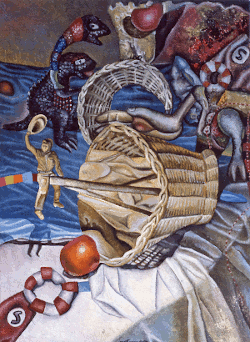
Seacape Still-Life (1987)
None of the paintings created in the first semester of my second year were as good as what I created in Memphis over the previous summer. The social stimuation I received living away from home stifled both my creativity and my concentration. In that third semester, I completed only a small handful of unspectacular paintings. One was repainted (with little improvement). I did not hit my stride until the last semester.
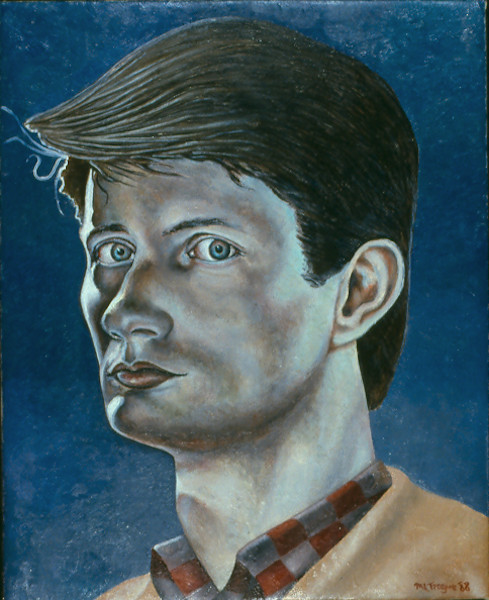
Self Portrait in Oil (1987-1988)
This painting was created in Memphis over Christmas break.
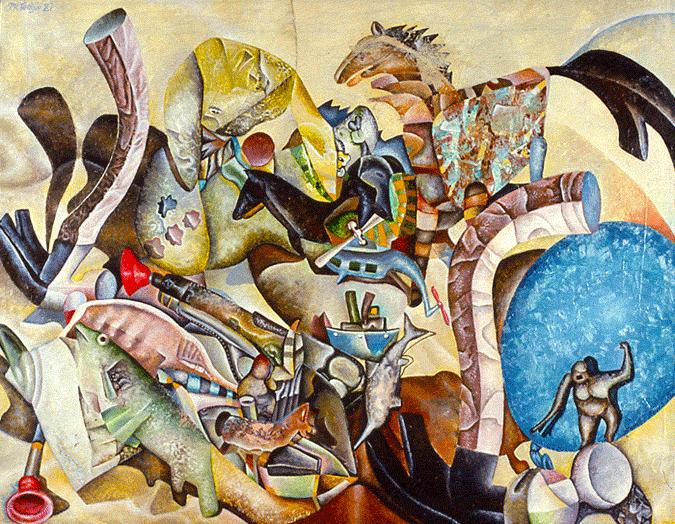
Toy Lies (1987)
The reflective patchwork of the brilliant blue balloon is due to use of Rapid-Set painting medium. (See note below.) This is also the first occasion where I used Naples yellow oil pigment.
Still-lifes have always provided a way to jumpstart my imagination, but beginning here I am thinking about the function of negative space and how to use a unifying color to blend between background and foreground.
The Last Semester, 1988
Rapid-Set Medium: Rapid-Set* medium was exactly what its name implied. It was a fast-setting oil paint medium. Given my thin application of paint in these days (prior to my development of a scumbling technique), my paints dried exceptionally fast, with the paint skin being both sticky and brittle. There was a great deal of drag on the brush, and not much time to blend. The feel was similar to the approach where viscous, undiluted stand oil is applied with a stiff bristle brush. Rapid-Set made my calcium carbonate oil-primed canvases feel encaustic. Acidic color further enhanced this effect: i.e., Mediterranean earth tones intermingled with bright plastic colors.
(*I cannot find my old bottle of this discontinued painting medium. I believe Liquitex made Rapid-Set.)
I had little experience in pure “oil painting,” and consequently adopted Rapid-Set from instructor Robert Barnes, who was then experimenting with it. Barnes once complained that, when he took up a brush to use the stuff, he did not slow down for fear the brush would stick fast to the surface of his painting and he would be unable to remove it. Once I moved into an apartment, I abandoned this toxic medium for stand oil, and later returned to refined linseed oil to facilitate finer details.
In retrospect, I think my late graduate school works show, in their small way, the influence of Robert Barnes, who I regard to be one of the finest abstract-figurative painters of modern times.
Hover to find linked images.
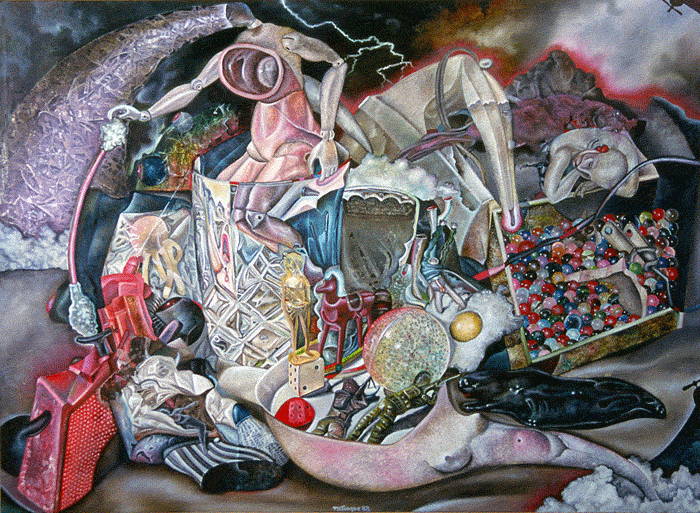
When War Brides Wax Still-Life (1988)
Indiana University’s painting program preferred a Mediterranean palette of Naples yellow, sienna, umber, and Venetian red. Greens were of a blue tinge.
Negative space in this picture is carved out around the edges of the still-life. Similar to Toy Lies, space is used as a framing device.
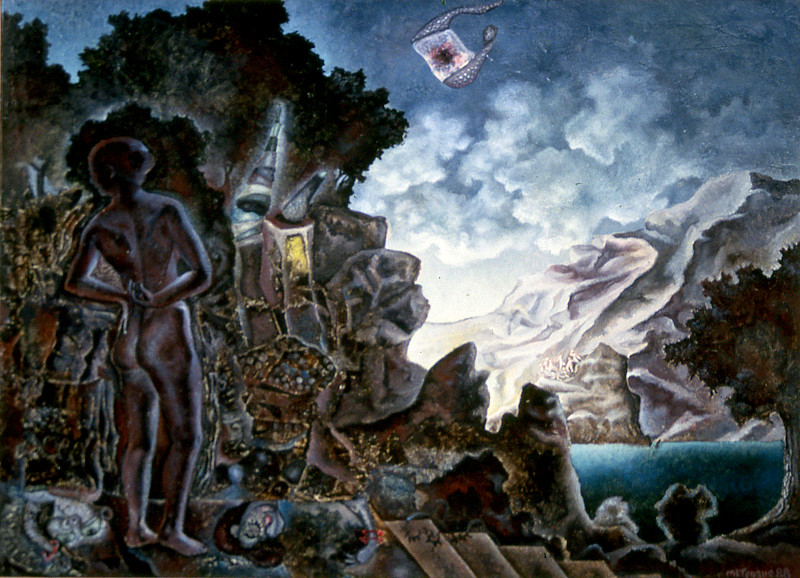
Giddy Girls and Logic (1987)
Cynicism replaces unfettered Romanticism. Oil on canvas
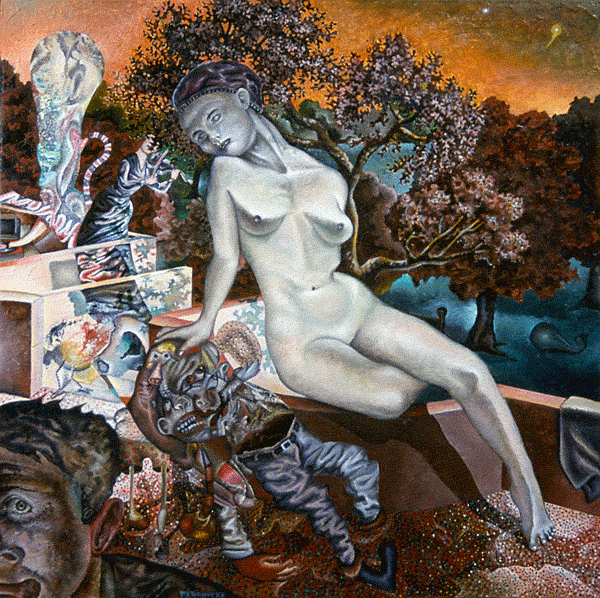
Que Sais-je? (1988)
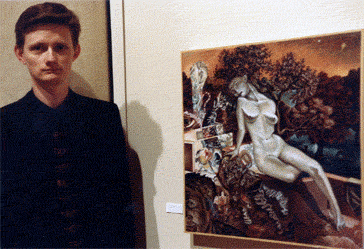
More use of a limited palette, similar in approach to Giddy Girls and Logic and other works of this period. In the second photograph, I stand next to Que Sais-je? at my MFA show opening.
The Figure | Ground Dilemma: Time allows one to see influences that were not apparent at the time they were forged. Painter James McGarrell, who taught at IU prior to my joining the program in 1986, gave a guest lecture and slide presentation during my residency there. I remember thinking his work, in terms of how he was building up his dense compositions, not dissimilar to my own interests. His work, however, preserved the figure/ground distinction, where I played it fast and loose.
This figure/ground distinction was less maintained in the work of his IU colleague, Robert Barnes, although, here too, it informs his work. Both men love lurid color, and for whatever tearing-through-the-fabric-of-realism they engaged in, they came to the same solution for the figure/ground problem: namely, bright color, diffuse light, and busy composition are pushed to the background, much as in a fantastical landscape, while foreground, where figures reside and occupy passable functional space, is darkly shaded and simpler. This creates a theatrical shadow box effect, and it is quite striking.
Had I kept the abstract-figurative style I explored at IU, it is likely I would have hit upon this figure/ground solution for dense paintings. As it was, I explored other solutions to this dilemma. Giddy Girls and Logic, Que Sais-je? and The Table (seen below) segregate the two opposing forces: one half of the canvas is occupied by clutter (chaos), while the other is occupied by conventional space (order).
Summer, 1988
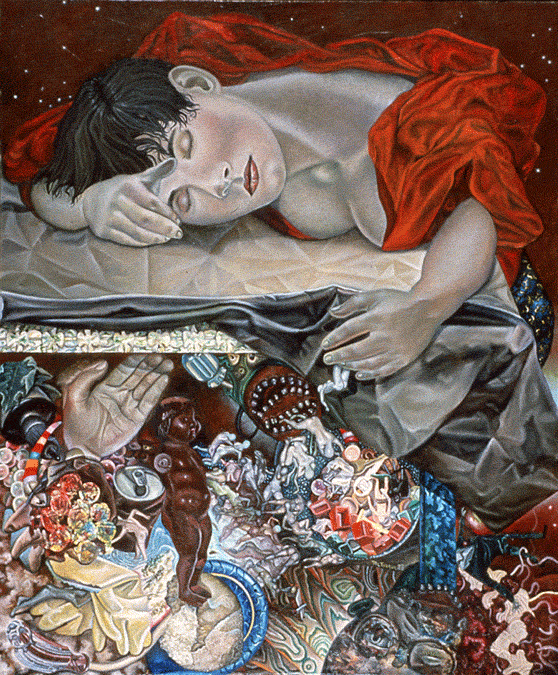
The Table (1988)
This is my last IU studio painting completed during the summer 1988, and after fellow graduates from the program quit their Pine Hall studios. Pine Hall, which had served as barracks for returning GIs from WW II, was torn down within a year or two of my graduation. I had a corner studio in this old building during my second year of study. Window views overlooked two directions of campus, including a wooded brook. This was an improvement over my first studio, which had no windows.
I made one other painting during the last days of this studio. It was much smaller so I could carry it to Chicago later in May. I never photographed this painting, and wonder if I did not copy over it in creating a better painting seen on the next page: Apparatus of Weaning. I do not know this for sure, but I remember this little painting sharing some of The Table’s chocolate brown color scheme, which is also true for Apparatus of Weaning.
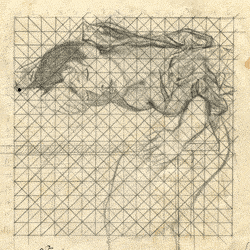
The Table (Study) 1988: This is an aged study found among random papers. On the flip side of this is the beginning of a draft letter to the Phyllis Kind Gallery in Chicago. It was the one gallery in the Midwest to which I aspired to gain entry, chiefly because its association with The Chicago Monster (Harry Who?) School of painters. I received a positive letter of encouragement from the gallery director, who unfortunately informed me that the gallery was relocating to New York.
(Phyllis Kind, who was receptive to outside artists, passed away in 2018, and her present website is filled with broken links.)
Postpartum Depression: Though I have never been one for making close friends, I find a society, in which I can mingle at a discreet distance, to meet needs I cannot articulate. Resultantly, I experienced a form of postpartum depression in losing both graduate school life and my life at the graduate residence, Eigenmann Hall; this included its cafeteria. To this day, these “safe spaces,” and threats to their security, appear regularly in my dreams.*
I did have a few friends in graduate school, and even after graduate school when I worked at the IU Art Museum. These friendships were formed with fellow art guards who were close to my age. Many were in graduate programs, so this intellectual stimulation was a continuation of the life I had in graduate school.
None of these friends were in art programs, however. As a consequence I felt a strange sense of banishment from a society to which I never fully belonged, even while I had dwelled in their company. My impression (though it may have been mostly in my head) was one of being looked down upon whenever I was seen in the museum by art faculty or graduate students. Regardless, I avoided contact with professors who would have strongly disapproved of me hanging around in Bloomington after graduation.
After a year and a half, I was forced to give up my job as an art guard, so the postpartum depression I experienced after graduation returned, but not completely since, by then, I was well immersed in a new community built around baristas and coffeehouse society. With each iteration of a social pattern, the amount of society within it diminished. This society had vanished entirely by 1996.
Once I stopped going to my favorite coffeehouse, this meant that my comicbook art work, which I was pursuing during these visits, decreased in amount. I did frequent other coffeehouses occasionally, so I did not give up drawing completely. This re-ordering of priorities allowed more time for painting, and by 1998 I had rediscovered my purpose as a painter.
The last two pages of my Portfolio deal with these in-between years leading up to 1998, beginning with preparation for my one-man Chicago show (1988-1990) and ending with the discovery of the Lowbrow Art Movement around 1997. The story, from there, moves to my Gallery pages and the first paintings of my mature style.
(*This need for security and structure, similiar to the informal family life I had in Memphis, may be explained by autism. [I discuss this condition on the next Portfolio Page.] Autism also explains why I drew so much creative energy from these settings, since I did not have to devote any energy to stress about my survival.)
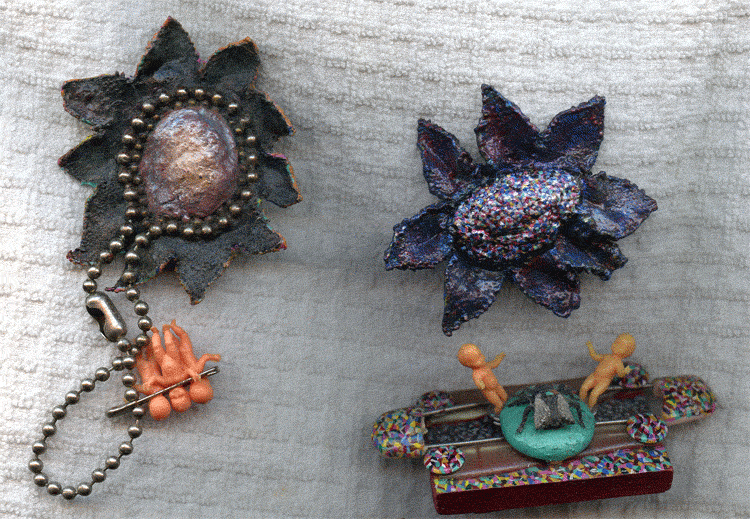
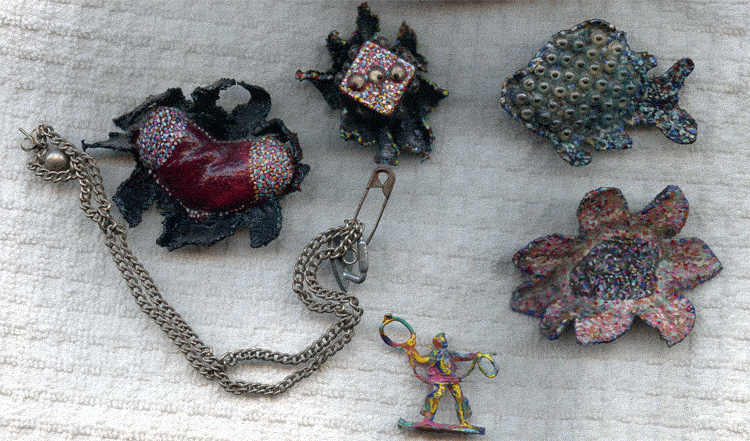
Acrylic, iridescent acrylic, and found objects decorate cloth sculpture. 1988-1989.
During my time as an art guard at IUAM, I was rather dapper and designed jewelry for myself to wear. (You could think of this as the third year of my MFA degree, only I was the gallery wall upon which my wares were exhibited.) These pieces, painted in acrylic and finished with synthetic varnish, were throwbacks to my days of making cloth sculpture.
During this same time frame, I created a few sculptural pieces for women to whom I was attracted. I soon realized it was less labor intensive to write them zany letters filled with drawings.
×
![]()
×
![]()
Next/ Back/ Artworks Portal Page
Copyright © 2016 michael l. teague all rights reserved.










